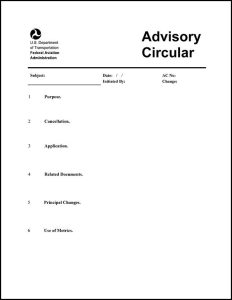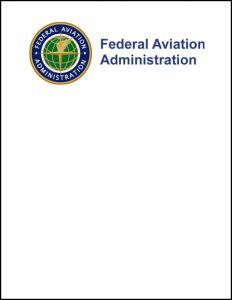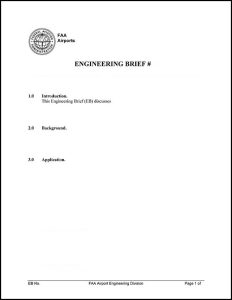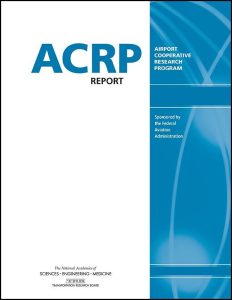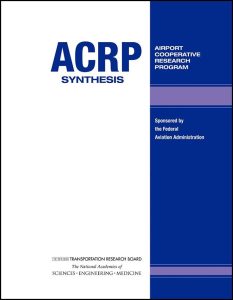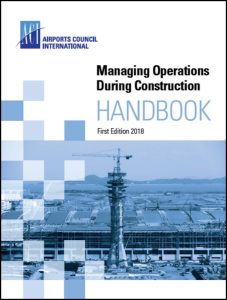To narrow the library of airside resources, use the filter boxes or airport map below or search box above.
Click an item below to expand.
Resources Matching Your Search
2017
This advisory circular (AC) establishes a common, uniform definition of critical aircraft for all deliberations of the FAA Office of Airports, inclusive of planning and environmental, design and engineering, and financial decision-making regarding airport development.
2021
This resource is a webpage that provides information on the Electronic Code of Federal Regulations (e-CFR) Title 14, Chapter I, Subchapter E, Part 77, which contains guidance on the safe and efficient use as well as the preservation of the navigable airspace.
1983
This advisory circular (AC) provides guidance for noise control and compatibility planning for airports under Federal Aviation Regulation (FAR) Part 150 and the Aviation Safety and Noise Abatement Act of 1979 (ASNA) (P.L. 96-193). It is intended for use by airport operators, state and local planners and other officials, and interested citizens who may engage in noise control planning.
2005
This advisory circular (AC) provides guidelines for airport designers and planners to determine recommended runway lengths for new runways or extensions to existing runways. It contains sections for aircraft with maximum certified takeoff weight of 12,500 pounds, more than 12,500 pounds, and more than 60,000 pounds along with design rationale.
2017
This advisory circular (AC) sets forth guidelines for operational safety in airports during construction. This AC assists airport operators in complying with Title 14 Code of Federal Regulations (CFR) Part 139, Certification of Airports. For those certificated airports, this AC provides one way, but not the only way, of meeting those requirements. The use of this AC is mandatory for those airport construction projects receiving funds under the Airport Improvement Program (AIP). Chapters include planning an airfield construction project, construction safety phasing plans (CSPP), and guidelines for writing a CSPP. Included in the appendices are a safety and phasing checklist and a construction project daily safety inspection checklist.
2022
This FAA presentation discusses basic concepts in taxiway design for runway incursion prevention from Advisory Circular 150/5300-13B, Airport Design. Airport planners and designers must understand these concepts to design a safe and efficient taxiway system.
2020
This desk reference provides explanatory guidance for environmental impact analysis performed to comply with Council on Environmental Quality (CEQ) Regulations for Implementing the Procedural Provisions of the National Environmental Policy Act (CEQ Regulations) (40 Code of Federal Regulations (CFR) parts 1500-1508); U.S. Department of Transportation (DOT) Order 5610.1C, Procedures for Considering Environmental Impacts; and Federal Aviation Administration (FAA) Order 1050.1F Environmental Impacts: Policies and Procedures.
2015
This advisory circular (AC) contains the FAA specifications for unlighted and lighted signs to be used on taxiways and runways. Six types of signs are specified in any of five sizes, five styles, and two classes, with any exceptions noted.
2020
Engineering Brief (EB) 100A addresses the FAA's recent completion of a safety risk assessment of the proposed modifications to the instrument departure surface described in FAA Order 8260.3, United States Standard for Terminal Instrument Procedures (TERPS). This EB provides approval for airport operators to implement the new departure surface for locating holding positions on the airfield.
2020
A hot spot is defined as a location on an airport movement area with a history of potential risk of collision or runway incursion and where heightened attention by pilots and drivers is necessary. By identifying hot spots, it is easier for users of an airport to plan the safest possible path of movement in and around that airport. Planning is a crucial safety activity for airport users—both pilots and air traffic controllers alike. By making sure that aircraft surface movements are planned and properly coordinated with air traffic control, pilots add another layer of safety to their flight preparations. Proper planning helps avoid confusion by eliminating last-minute questions and building familiarity with known problem areas.
2019
The data from this website portal helps the FAA collect airport and aeronautical data to meet the demands of the Next Generation National Airspace System. This tool allows airports to use the wind data to prepare a windrose for the airport.
2020
Part 1 provides guidance on the geometric design of runways and the airport elements normally associated with runways. It discusses runway configuration, runway length, airplane performance parameters affecting runway length, and planning to accommodate future aircraft. This resource is available at the ICAO store for $150.
2016
ACRP Research Report 168 helps airport operators evaluate the risk of an aircraft accident within a runway protection zone (RPZ). Although RPZs are supposed to be clear of structures and people, it is still common for activities to occur within an RPZ for many reasons, and these reasons can be beyond the control of the airport operator. The report is accompanied by a tool used to assess the risk of an aircraft accident within the RPZ and, based on that output, assess the risk to people and property, considering population density and land use. The tool can be used to run scenarios for planning around an RPZ or if changes are being considered, such as a change in the threshold, extending a runway, removing a hazard, and planning for a new runway.
2018
ACRP Synthesis 93 compiles information and examples that successfully demonstrate the value of building sustainability concepts into capacity-enhancing projects. The report describes additional resources and tools that provide information on how to select, apply, and communicate sustainability measures. The report explores how sustainability efforts often build on themselves, how lessons learned from one initiative are carried through to the next, and how this progressive learning process can enhance sustainability's role in capacity-enhancing projects over time.
2018
Construction activities can have a variety of impacts on the daily operations of an airport. To address this issue, a working group of the ACI World Safety and Technical Standing Committee developed the Managing Operations During Construction Handbook, which consists of best practices and case studies. The focus of this manual is on construction projects that affect the safety and efficiency of airside operations. The handbook presents a summary of the issues that airport operators should consider in developing management plans for operations during construction works. This handbook is for reference by airport operators, project managers, security agencies, aircraft operators, air navigation service providers, civil aviation authorities, contractors, and local communities. This resource is available from the ACI store for $180 for members and $1,000 for non-members. There is also a short course on the topic available from ACI for $95.
2020
This advisory circular (AC) describes the standards and provides guidance in the development of a surface movement guidance and control system (SMGCS) plan for U.S. airports, in which scheduled air carriers are authorized to conduct operations when the visibility is less than 1,200 feet runway visual range (RVR). An SMGCS plan facilitates the safe movement of aircraft and vehicles on the airport by establishing more rigorous control procedures and requiring enhanced visual aids.
2015
This advisory circular (AC) provides guidance for the preparation of master plans for airports that range in size and function, from small general aviation to large commercial service facilities. The intent of this AC is to foster a flexible approach to master planning that directs attention and resources to critical issues. The scope of each master plan must be tailored to the individual airport under evaluation.
2015
This advisory circular (AC) provides guidance for airport sponsors in the selection and engagement of architectural, engineering, and planning consultants. It also discusses services that normally would be included in an airport grant project, types of contracts for these services, contract format and provisions, and guidelines for determining the reasonableness of consultant fees.
2012
This advisory circular (AC) contains standards for the planning, design, installation, and maintenance of engineered materials arresting systems (EMAS) in runway safety areas (RSA). Recognizing the difficulties associated with achieving a standard safety area at all airports, the FAA undertook research programs on the use of various materials for aircraft arresting systems. These research programs, as well as evaluation of actual aircraft overruns into an EMAS, have demonstrated its effectiveness in arresting aircraft overruns.
2020
This policy guidance document provides clarification to the Airports Division Regional Office (RO) and Airports District Office (ADO) program managers (PMs), planners, and engineers on the use of declared distances for non-turbine-powered airplanes.
